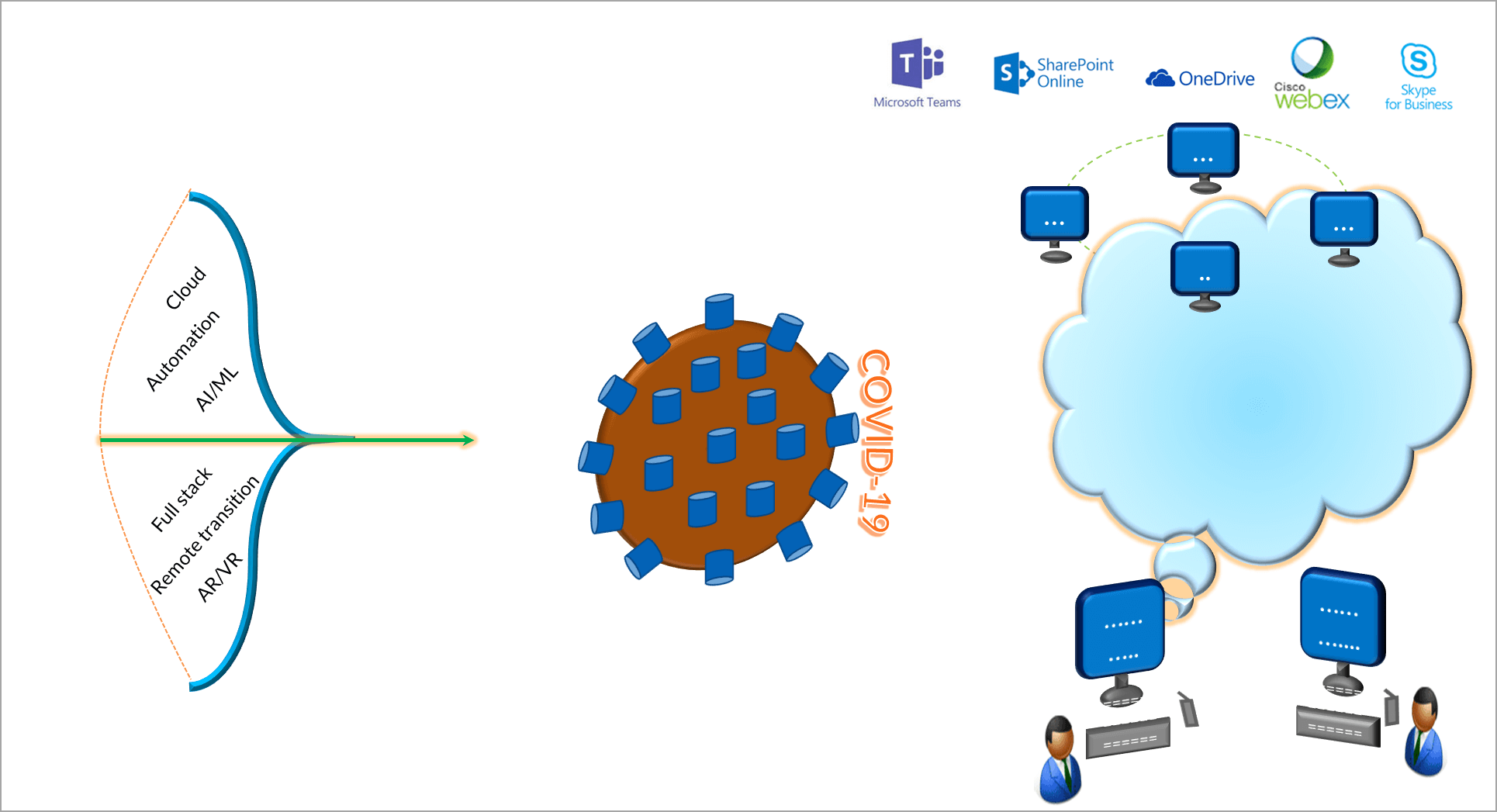Hexaware Acquires SMC Squared, a Leader in Building Global Capability Centers-Rolls Out GCC 2.0 Service Line. Learn More
This website uses cookies. By continuing to browse the site, you are agreeing to our use of cookies
COVID-19: 6 Effective Strategies to Manage Agile DevOps from Remote Workspaces
Cloud
June 11, 2020
How COVID-19 is Changing the Modern Delivery Work Patterns?
As the whole world is grappling with COVID-19 crisis, the global IT delivery leaders are heading up to a new challenge – how to manage work remotely and still deliver hyper-productivity. Realizing this in the long-term involves not just a very practical and workable design thinking, but also a robust modern architecture that can neutralize professional and personal constraints of the teams and leaders alike and enable them to perform seamlessly without any mental stress. With work-from-home set to become the new norm post-COVID-19, it is going to be a challenge to deliver optimal product management with limited hardware and software resources at hand. Another major hurdle will be less frequent face-to-face team discussions and thus, more onus will be on each team member to perform independently (yet in coordination with other team members) while working in resonance with organizational goals.
Delivering from distributed locations is the basic tenet of agile development and methodology, which is the foundational element of Modern Delivery. But coupling it with work-from-home culture will require a thorough SWOT analysis of the enterprises to gauge how much and how fast they can stretch themselves in imbibing these new value-sets (both technologically and psychologically) without impacting business. This shift, either partial or complete, from office-based to home-based culture will require major changes in almost all the core areas like budgeting, hiring, training and development, data management, and cybersecurity to ensure simple yet efficient workflow patterns. Furthermore, a major shift in mindset is needed, or rather inevitable, to adapt to this new culture and work patterns.
So, how to build a path when there is so much to do and still maintain an equilibrium at all stages to ensure hyper-productivity?
6 Effective Strategies to Ensure Seamless, Secure, and Stable Agile DevOps from Remote Workspaces

1. Make Cloud the New Normal
When working remotely, especially during unprecedented and difficult times like COVID-19, the most vital provision that an organization must ensure for its teams is highly reliable, secure, and available resources. This can help teams to work cohesively by connecting and communicating with peers seamlessly for enhanced collaboration, getting work-related or other constraints resolved on-the-go, sharing documents or other collaterals (as permitted by the organizational IT policies) over the network, connecting with clients as and when needed, attending webinars/ online trainings, using virtual desktops and so on.
To make this happen seamlessly across the entire workforce (technical, non-technical, as well as support teams), an organization must adopt cloud in its fullest form. Cloud is the most practical and logical option to get on-demand scalability, flexibility, and performance assurance across distributed locations. For large enterprises who are looking for great application cloud replatforming options, Hexaware’s amaze® product suite for cloud replatforming can play a crucial role. It not just reduces TCO by more than 50%, but also decreases cloud replatforming time from the usual 8-10 months to just 4-6 weeks. As a result, the time-to-market improves incredibly.
2. Identify Automation and AI/ML Opportunities
Agile DevOps and automation go hand-in-hand for very natural reasons. When there is a dire need to be always hyper-productive, a team cannot afford spending time and efforts on mundane and repetitive tasks. Also, when there is a demand to deliver more than what is asked for, automation does play a dominant role in completing tasks faster and with high precision.
Having said that, an organization must identify areas where it can automate and apply AI/ML techniques. Using chatbots for users, automation pipeline for CI/CD, data gathering and monitoring for insightful analytics, day-to-day performance monitoring with metrics, identifying and resolving issues automatically etc. are some of the core areas where automation and AI/ML can play a very constructive role.
Automation coupled with AI/ML is not just to save time and efforts. It can also reduce TCO very fast and drastically, as less human intervention will be required and thus, resources can be used optimally. With the power of prediction, automation, and self-learning, automation and AI/ML can make agile DevOps implementation more robust and transparent, especially in challenging time like COVID-19 when teams are distributed across multiple locations globally.
3. Go for Full Stack Development
In today’s era of agile BizDevOps, organizations must be extra careful when utilizing their teams for development and operations. The developers must be thoroughly trained to handle full stack of the frontend and backend technologies along with being comfortable in operations technology as well. Full stack development needs to be the new norm but in a very strategic way so that the developers for development and operations can work in sync and understand their role clearly.
Having full stack developers gives a major boost to team performance as teams can deliver with full capacity towards a single goal without deviating from the pre-determined development approach. This becomes increasingly effective when teams work remotely as they can collaborate and coordinate easily, without any specialized training.
4. Adopt Effective Remote Transition Techniques
When teams are working from remote locations, organizations need to have a strong transition process in place which enables smooth and time-bound transition without impacting client’s day-to-day business. Some of the key areas to focus on include:
- Best-in-class collaboration tools for 24×7 connectivity across geos
- Virtual meeting rooms for team discussions and client meetings
- Setting up protocols for engaging clients and vendors so that their work is not impacted during transition
- Minimum knowledge loss during SME collaboration, by using advanced communication tools
- Seamless connectivity (both audio and video) for faster and smoother transitions
5. Invest in VR and AR for Training and Development
Delivering hyper-productivity with agile DevOps is not possible without having innovative and well-architected training and development plans in place. During the challenging times like COVID-19 when there are many restrictions on mobility and social life of an individual, it is obvious that the person may not be updated on the latest happenings in the industry and how the world is progressing technologically.
To fill this knowledge gap, the teams need to be constantly updated via training sessions and certifications even when they are working from home. As the teams are working from outside of office premises, they will have very limited availability to hardware and software resources. In such scenario, conducting training and development programs by leveraging Virtual Reality (VR) and Augmented Reality (AR) based techniques will not only enhance their training experience, but also provide them with a stress-free learning platform.
6. Security – Go for More Measures than Required
Security is one critical area which needs expert vigilance 24x7x365. There should not be any security lapse even for a second as it can lead to irreversible losses both for the organization as well as its customers. An organization should invest and implement much more than it thinks is enough when it comes to adopting and enforcing security measures. This is vital, especially when teams are working from home or remote workspaces, as they might be using different devices like personal computer, laptop, mobile phones, tablet etc. for performing tasks, and for communicating and collaborating with people not just within the team, but also non-team members like HR, admin etc.
Plan for a modern security architecture (by complying with all the necessary standards) right at the start of the project planning and implement it in iterations during each sprint. Security is usually considered as NFR (Non-functional Requirement) and thus, add acceptance criteria for security-related tasks in the user stories itself so that it progresses simultaneously with other functional requirements. Make the codes more and more secure and perform thorough security testing at every level. To test the real-time effectiveness of security levels, the development team can even ask the respective stakeholders to perform frequent security tests. This will help to identify vulnerabilities as early as possible and plug the gaps to avoid phishing or other malicious attacks.
The security architecture must be designed considering all these scenarios. At the same time, having too many security walls in place can also hamper work continuity at large. So, a proper balance is extremely essential for smooth agile development and seamless product management. Furthermore, it is necessary to train teams on what all security measures have been adopted and how to adhere strictly to the same. Also, an occurrence of security lapse due to manual errors, like clicking on a malicious link or getting trapped into phishing attack, cannot be ruled out. To recover from such unanticipated challenges, a strategic damage control mechanism should be in place for faster and smoother recovery. Automation can play a great role here in identifying and healing security infringements automatically (either manually or by the system).
Shifting of Mindset is the Key to Success
COVID-19 is definitely going to change business equations at large as the impact of this pandemic will not be just economical, but also behavioral. Touchless behavior, increased use of technology, social distancing etc. will take precedence over current human habits. Thus, for successful agile DevOps implementation from remote workspaces, organizations will be forced to start investing in areas which were once considered to be optional – like cloud-native development, API and microservices, automation, AI/ML, cybersecurity etc., with robust and user-friendly work-from-home arrangements. Shift of mindset from project-based to product-based will surely give a competitive edge by neatly weaving business, IT, and end users for faster time to market and delightful customer experiences.
About the Author

Mandar Joshi
Read more
Related Blogs

Understanding Snowflake Cortex for Gen AI Applications with Sensitive Data
- Generative AI
- Cloud
- Data & Analytics

Ready to Pursue Opportunity?
Every outcome starts with a conversation
















